#sargasso
Explore tagged Tumblr posts
Text

sargasso the drowned, witch of bitter waters
i wanted to design a character inspired by sargassum algae. she is probably hiding gills under that neck scarf
#character design#monstergirl#witch#art#oc#sargasso#she is some kind of undead revenant and her familiars are eels :]#i feel like she would be an end-stage boss in some hypothetical horror game
286 notes
·
View notes
Text
Super late to this trend, but I doodled my Gojis' eyes for fun

57 notes
·
View notes
Text

79 notes
·
View notes
Text

Paul Alexander (1937-2021) “Sargasso” by Edwin Corley (1978) Source
3 notes
·
View notes
Text

Challenge #04072-K054: The Gravy Recovery Project
My name is Joi, and almost my entire life, since leaving Earth, I helped gravy drives escape Sargassos and retire peacefully. My love and I had children, and several were born as I was, at least with the same gift. Now we work as a business / charity, and we're happy. As is our beloved friends sailing through the stars.
https://peakd.com/fiction/@internutter/challenge-03193-h284-to-hear-them-singing -- Anon Guest
It's rarer than one might think, to find an abandoned gravy drive in a Sargasso. Only Dereggers are cruel enough to abandon something like that with nobody to care for it.
The Nae'hyn don't bring their engines to the people who do that.
For Joi, it's a job that takes her to every known Sargasso in the Alliance. Listening for the lonely songs. So the Nae'hyn can find and recognise their own. She spent the best years of her life singing with the ships that carried her from one place to another. What surprised all of them was the discovery of gravy drive colonies.
[Check the source for the rest of the story]
5 notes
·
View notes
Text


2 notes
·
View notes
Text
@likeahyacinth
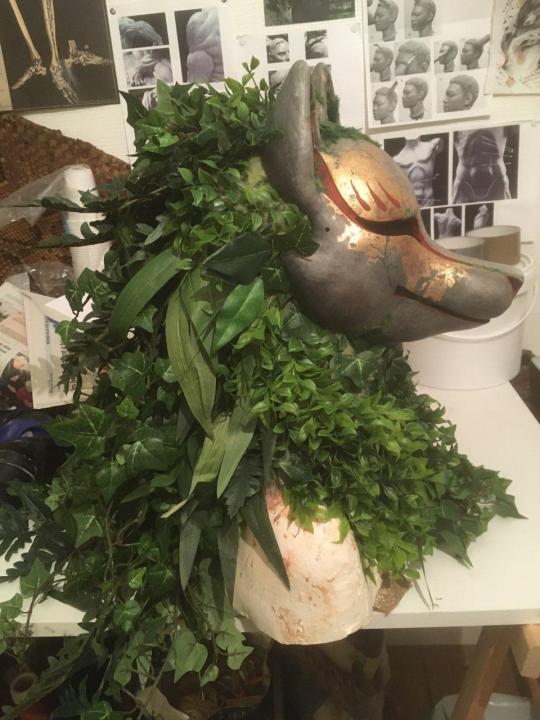
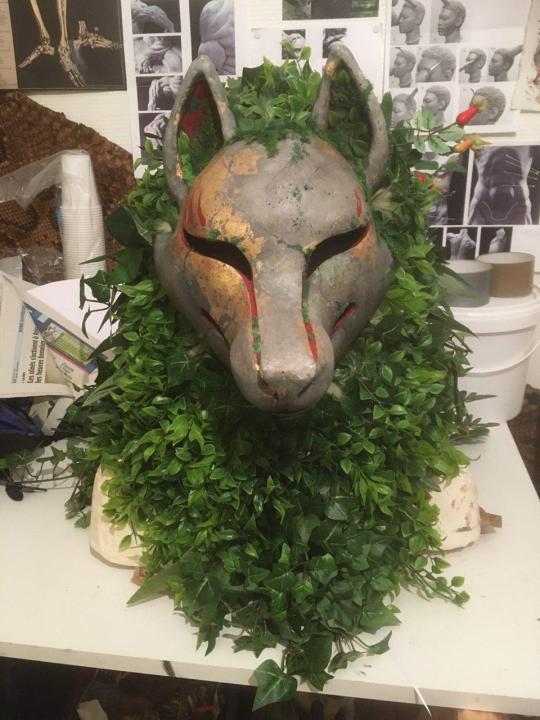


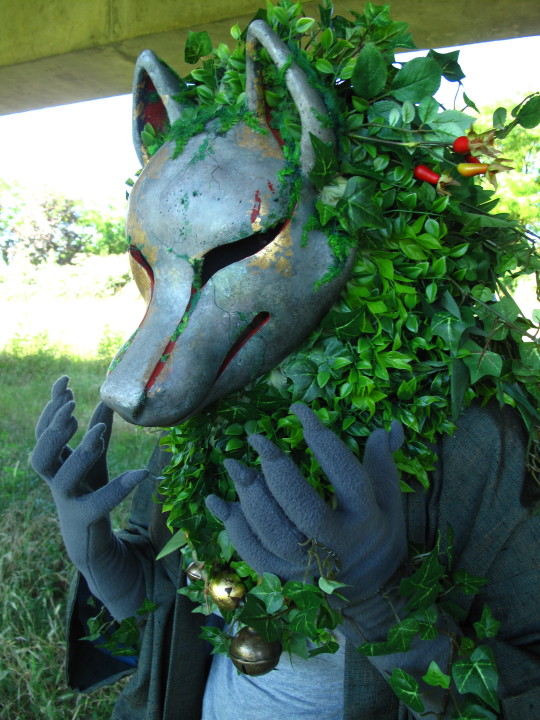
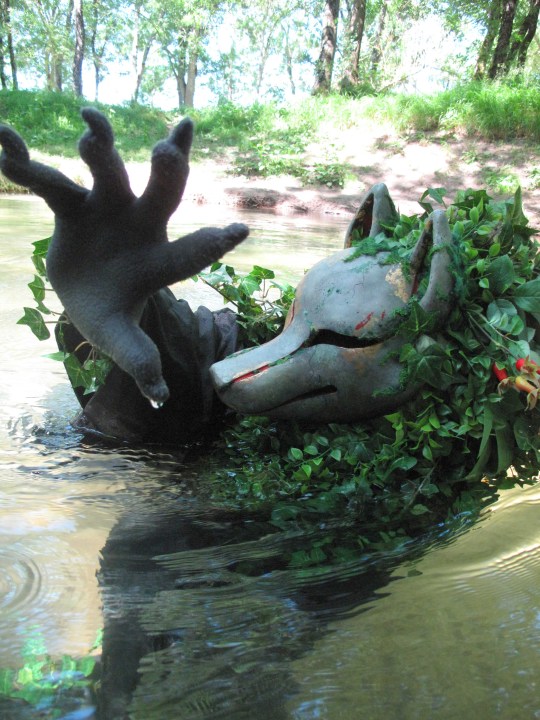
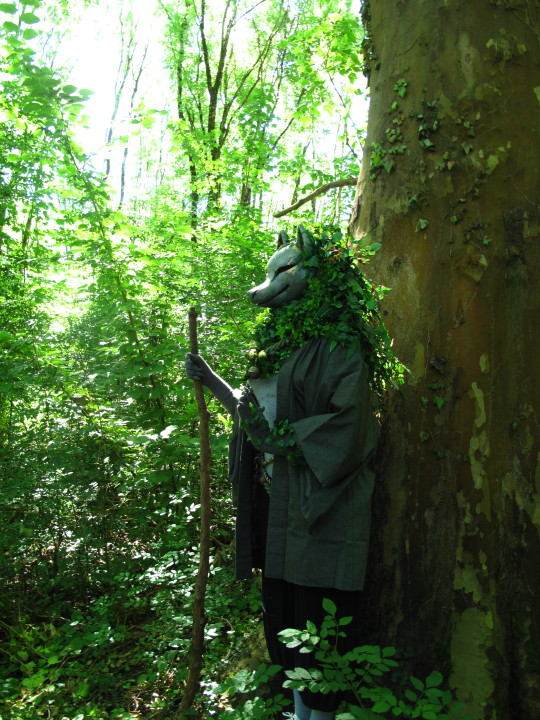
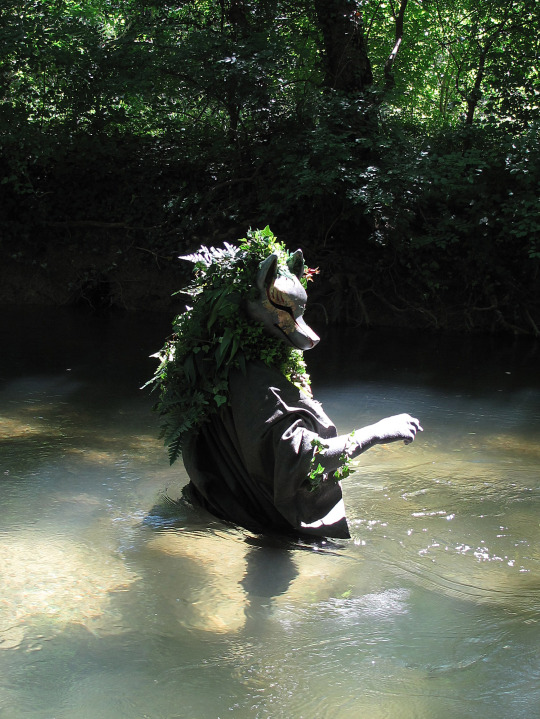
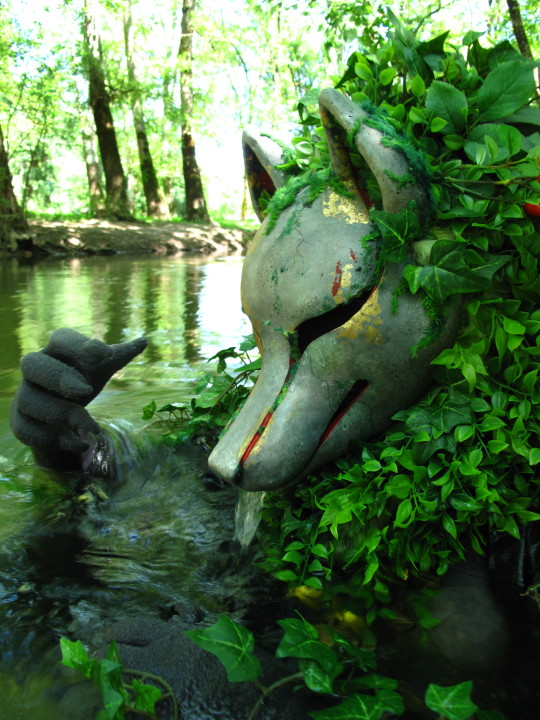
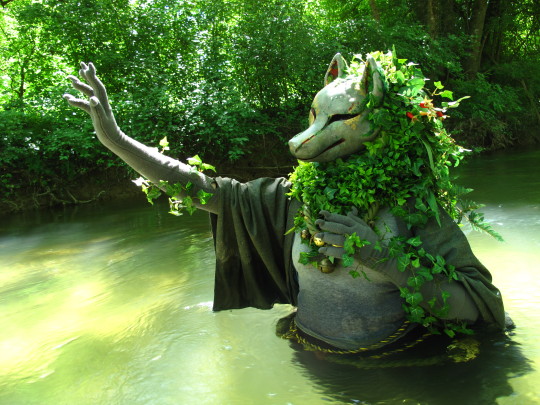
Shida !
Personnal suit. Polyurethane resin mask, acrylique paint, gold leaf, fake fur, artificial plants. Fleece glove (with artificial plants too)Curtain ropes and bronze bells.
Pictures by @gayshi
25K notes
·
View notes
Text

Sargasso-dennis hearzing figure #dragon
0 notes
Text
Slimmere zonnepanelen
Het laatste jaar is er veel te doen geweest over zonnepanelen. Eerst over de plannen van het Kabinet Rutte IV om de salderingsregeling geleidelijk af te schaffen. Een voorstel dat verworpen werd door de Eerste Kamer. Vervolgens doordat de nieuwe coalitie van PVV, BBB, NSC en VVD in het hoofdlijnenakkoord van plan is de salderingsregeling in 2027 in een klap af te schaffen. Tegelijkertijd wil de…
0 notes
Text

algae woman. would you let her entangle you in her cold and slimy embrace. if she asked super niceys
#art#sketch#character design#oc#sargasso#sheeee is inspired by sargassum algae. hence the name#other visual inspos include the way botticelli painted the hairstyles in the birth of venus and 90s mugler runway shows
17 notes
·
View notes
Text
Sargasso goji sketch!

More about the au
118 notes
·
View notes
Text
my favourite literary genre is when a woman goes absolutely insane in first person narration - i'm right there with you girlie
#the yellow wallpaper#the vegetarian#the bell jar#wide sargasso sea#english literature#reading#the secret history
279 notes
·
View notes
Text
Wet Beast Wednesday: American eel
It's time for an American creature that is notoriously slimy and slippery. No, it's not our politicians this time, this one actually makes the world a better place. It's the American eel, an eelongated fish with an eelaborate lifecycle. Sadly, human activity has made this once-common critter much more eelusive, to the point it may go extinct. Allow me to eelaborate about this exceellent fish (ok I'll stop).

(Image: an American eel resting on a muddy bottom. It is a long, snake-like fish with a fin running down the rear 2/3rds of the body and around the tail to the underside. There are two small pectoral fins near the head. The head is pointed and the jaws have prominent lips. The lower jaw just out beyond the upper jaw. It it a light brown in color, fading to white in the underside. End ID)
American eels (Anguilla rostrata) are long, slender ray-finned fish of the family Anguillidae, the freshwater eels. It is fairly typical of a member of that family. The body is cylindrical, like that of a snake's and the dorsal, tail, and anal fins have combined into one long fin that runs down the back, around the tail, and along the underside at the rear of the body. They also have a pair of pectoral fins behind the head. The head is pointed, with long jaws, the lower jaw being longer than the upper. Unlike most eels. which have lost their scales entirely, the Anguillidae still have scales embedded in the skin, but they are so small it is hard to notice them at all. The scales grow in irregular rows and do not overlap, unlike most fish scales. The body produces a thick, protective mucus coating. American eels can grow up to 1.2 meters (4ft) and 7.5 kg (17lbs), with females growing larger than males.
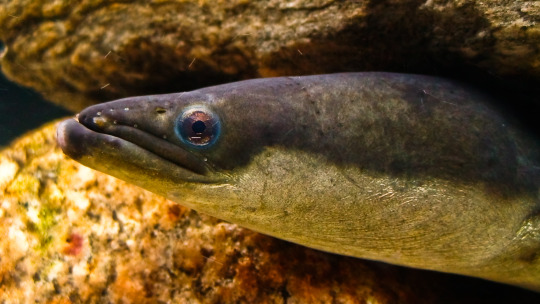
(Image: a close up of an eel's head, showing off the robust lower jaw and the eye. End ID)
American eels have one of the broadest range of habitats of any fish. They live in freshwater and estuaries along the eastern coast of North and Central America as well as northern parts of South America, the Caribbean islands, and southern Greenland. They primarily inhabit rivers and streams as well as and connected lakes and ponds and can range far inland, especially along the Mississippi River. They are predators with a wide diet, feeding on fish, crayfish, worms, fish eggs, amphibians, and dead animals. As with most eels, they are nocturnal and spend their days hiding in burrows or in areas sheltered by rocks, plants, or other structures. American eels are highly mobile and will travel vast distances through their lives. They can move against currents, up slopes, and across wet grasses or short distances of land and young eels are capable of climbing rocks and waterfalls. Some populations will migrate out to coastal areas during the spring and summer and swim upriver for winter. Other populations remain in freshwater or estuaries all year round. During winter, they will bury themselves in the sediment and hibernate until spring.
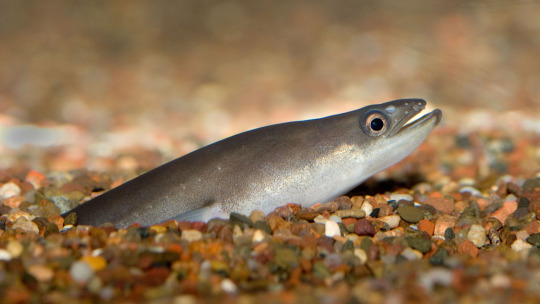
(Image: the head of an American eel poking out of a burrow in pebbly sediment. End ID)
For a long time, the life cycle of freshwater eels was a mystery. They seem to just appear as young eels with no sign of eggs or larvae. Aristotle thought the European eel (also in the family Anguillidae) were mature earthworms and that they appeared out of damp soil instead of reproducing. It was also believed for a long time that they couldn't reproduce as scientists, including Sigmund Freud (yes, that Sigmund Freud) dissected dozens of European eels without finding eggs or reproductive organs. The answer to eel reproduction came later. Freshwater eels, including the American eel, are catadromous, meaning they spend most of their lives in freshwater but migrate out to salt water to reproduce. Sexually mature American eels all travel to the same place to reproduce: the Sargasso Sea. The Sargasso Sea is a unique location in the Atlantic Ocean, a calm location bordered by currents and known for vast amounts of floating Sargassum seaweed. We know that the eels travel in massive numbers to reach the sea and mate all at roughly the same time, but we don't fully know exactly when or were their spawning ground is. They probably mate in massive conglomerations where fertilization is uniform and random, something called panmixia. The eggs likely take a few weeks to hatch and will hatch all around the same time. Large females can release up to 8.5 million eggs. They mate only once and die afterwards, a characteristic called semelparity.

(image: an eel resting on rocky sediment. This one is a darker grey color than in the first picture. End ID)
Eels have a type of larva called a leptocephalus. These larvae are thin and leaf-shaped, with translucent bodies that make them hard to spot. American eel larvae are carried by the Gulf Stream into the Gulf of Mexico and then around Florida and up along the eastern coast of North America. This can take up to a year. Once the larvae are carried over the continental shelf, they metamorphose into glass eels. In this stage, they now take on the typical eel shape, but are still translucent, hence the name. Glass eels gradually grow more pigmented as they move closer to shore. Once they become fully pigmented and move into estuaries and the mouths of rivers, they are known as elvers. Historically, elvers were the first stage that most people were aware of and they seemed to appear from nowhere. American eels remain as elvers for up to a year before they grow into yellow eels, named for their yellowish color that darkens to brown or grey as they age. This is the adult stage, but they are still sexually immature. In fact, up until this stage, they have not even differentiated into males and females. That happens during the yellow eel stage and seems to be influenced by populations. The denser the eel population is in the area, the larger the percentage that develops into males. The reason dissections of eels failed to find sexual organs or eggs is because they were dissecting yellow eels that hadn't fully differentiated yet. American eels can remain in the yellow stage for 10 to 25 years as they gradually mature. Once the eel's life starts to come to an end, it will metamorphose into a final stage called a silver eel. Silver eels undergo physiological changes to prepare themselves for their journey back to the Sargasso Sea. Their pectoral fins get bigger, their digestive tract degrades, the eyes shift to being adapted to a marine environment, the skin thickens to prepare for colder ocean waters, and fat builds up. Silver eels don't eat as they journey to the Sargasso Sea, surviving on fat stores that will last them a journey of up to 4,500 kilometers back to where they were born. Interestingly, the farther an eel travels from the Sargasso sea during its life, the larger it will grow and longer it will live before returning to mate.

(Image: a leptocephalus larva. It is a small, flattened, transparent animal with a tiny head and large eye. The body is overall the shape of a long, slender leaf. End ID)

(Image: a group of American glass eels resting on a yellow surface. They have the same shape as the adults, but are tiny and transparent, with only the eyes, parts of the skull, and spine being a darker color. End ID)
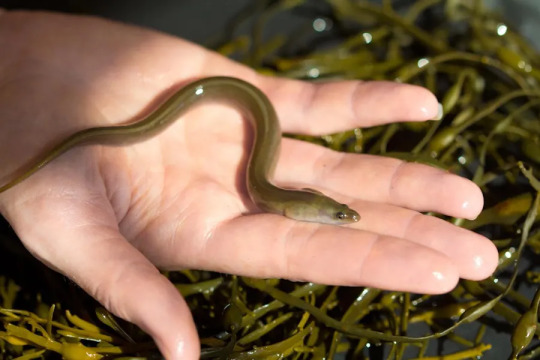
(image: an American eel elver being held in somebody's hand. It is small enough to fit in the palm and is a light greenish-brow color. It has the same body structure as an adult. End ID)

(Image: a yellow eel that has only recently reached this stage, as evidenced by its yellow-green color. It is being held in somebody's hand. End ID)
American eels are classified as endangered by the IUCN, who also described them as being at a very high risk for extinction in the wild. The population underwent a major crash in the 1980s, though it had been declining for a while already. The biggest cause of this decline appears to be dams. Young eels can often cross dams to get upstream thanks to their ability to climb, but adult eels trying to get back out to sea to breed are often blocked. Even if they get past dams, they are highly sensitive to low-dissolved oxygen environments, which waters just below dams tend to be. An eel could make it over the dam just to suffocate at the base. Since yellow eels are more likely to become female in low population density areas, the drop in population is resulting in an abundance of females with not enough males to fertilize all of their eggs. Pollution is also a problem as certain pollutants can accumulate in the eel's fat, then poison it during lean times. Overfishing is another problem, likely just as big if not bigger than damming. American eels have been eaten since ancient times and eel meat is considered a delicacy in many cultures. Because of how complex their life cycle is, American eels can't effectively be bred in captivity and so virtually all eel meat on the market is from wild captures. Eel meat labeled as farm raised is usually actually captured from the wild to be raised in captivity and is therefore not sustainable. Despite multiple attempts to give them legal protection, American eels have little protection in the US or Canada. Eels provide an important service to their ecosystems, being a major predator and food source. They also act as the hosts to larvae of certain mussel species. Freshwater mussels are one of the most endangered animal groups and the lack of their hosts isn't helping with that.
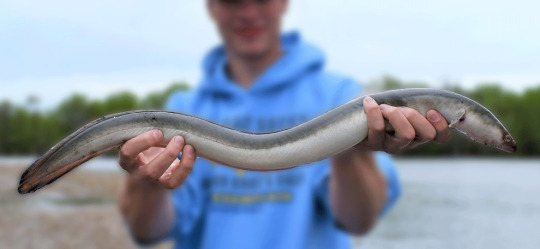
(Image: a mature American yellow eel or silver eel being held up to the camera by a person in a blue sweatshirt. The eel is longer than their arms and a grey color with white underbelly. End ID)
#wet beast wednesday#american eel#eel#eels#elver#glass eel#silver eel#yellow eel#sargasso sea#fish#fishblr#fishposting#eelposting#freshwater fish#estuarine fish#migratory fish#freshwater#freshwater ecology#biology#ecology#zoology#animal facts#informative#educational#image described
89 notes
·
View notes
Text

So, if you think you're desperate, New Zealand eels have to swim through the South Atlantic Ocean, round the bottom of Africa, then up past most of South America, in order to have sex and breed. No wonder it's a once in a lifetime thing.
142 notes
·
View notes

